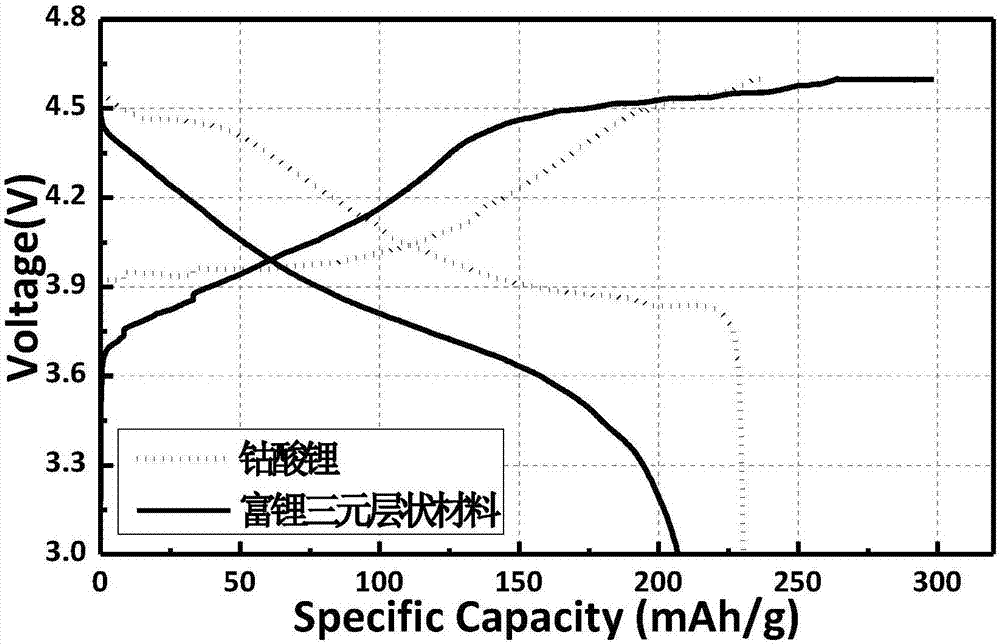Lithium ion battery
A lithium-ion battery, battery technology, applied in battery electrodes, secondary batteries, secondary battery charging/discharging and other directions, can solve problems such as the inability to ensure the positive effect of lithium-rich manganese-based solid solution materials, to avoid capacity decay, production process Simple, capacity-enhancing effect
- Summary
- Abstract
- Description
- Claims
- Application Information
AI Technical Summary
Problems solved by technology
Method used
Image
Examples
Embodiment 1
[0089] The cut-off voltage of charging and activation during capacity division is 4.4V; after capacity division, the charge-discharge cycle voltage window is 4.3V-2.8V;
[0090] Others are consistent with Comparative Example 1.
[0091] After testing, the volume energy density of the full battery (at a charge and discharge rate of 0.5C) reaches 645Wh / L, and the capacity retention rate of the full battery after 500 cycles (at a charge and discharge rate of 0.7C) is 87.2%.
Embodiment 2
[0093] Replace the electrolyte formula with: 1.2M LiPF 6 +Ethylene carbonate / ethyl methyl carbonate / diethyl carbonate / vinylene carbonate / fluoroethylene carbonate / propylene sulfite / succinonitrile / glutaronitrile / fluorobenzene (mass ratio 15:37:15: 1:10:3:3:1:1);
[0094]The cut-off voltage of charging and activation during capacity division is 4.6V; after capacity division, the charge-discharge cycle voltage window is 4.3V-2.8V;
[0095] Others are consistent with Comparative Example 1.
[0096] After testing, the volumetric energy density of the full battery (at a charge-discharge rate of 0.5C) reaches 666Wh / L, and the capacity retention rate after 500 cycles (at a charge-discharge rate of 0.7C) is 87.9%.
Embodiment 3
[0098] Replace the electrolyte formula with: 1.2M LiPF 6 +Ethylene carbonate / ethyl methyl carbonate / diethyl carbonate / vinylene carbonate / fluoroethylene carbonate / propylene sulfite / succinonitrile / glutaronitrile / methylene disulfonate / fluorobenzene ( Mass ratio 15:36:15:1:10:3:3:1:1:1);
[0099] The cut-off voltage of charge and activation is 4.7V during capacity division; the charge-discharge cycle voltage window after capacity division is 4.3V-2.8V;
[0100] Others are consistent with Comparative Example 1.
[0101] After the test, the volumetric energy density of the full battery (at a charge and discharge rate of 0.5C) reached 683Wh / L, and the capacity retention rate after 500 cycles (at a charge and discharge rate of 0.7C) was 88.3%.
PUM
| Property | Measurement | Unit |
|---|---|---|
| Thickness | aaaaa | aaaaa |
| Thickness | aaaaa | aaaaa |
| Compaction density | aaaaa | aaaaa |
Abstract
Description
Claims
Application Information
 Login to View More
Login to View More - R&D
- Intellectual Property
- Life Sciences
- Materials
- Tech Scout
- Unparalleled Data Quality
- Higher Quality Content
- 60% Fewer Hallucinations
Browse by: Latest US Patents, China's latest patents, Technical Efficacy Thesaurus, Application Domain, Technology Topic, Popular Technical Reports.
© 2025 PatSnap. All rights reserved.Legal|Privacy policy|Modern Slavery Act Transparency Statement|Sitemap|About US| Contact US: help@patsnap.com



